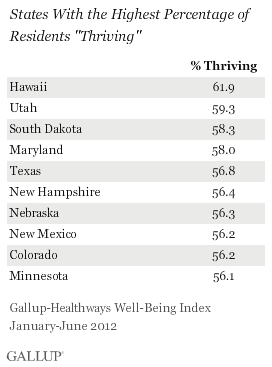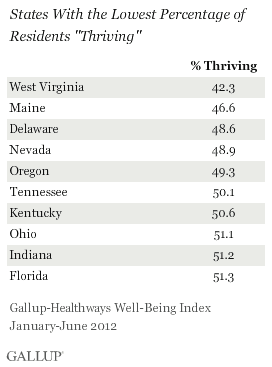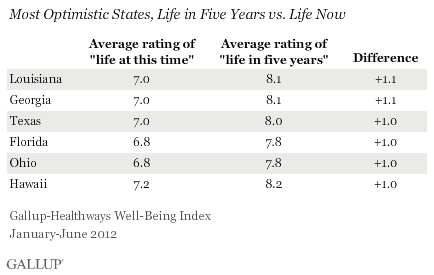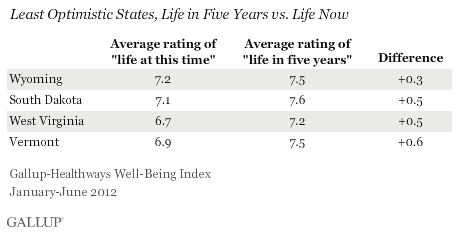WASHINGTON, D.C. -- Residents of Hawaii, Utah, and South Dakota were the most likely to be "thriving" in the first half of 2012 based on how they rate their lives today and their expectations for their lives in five years. Residents of West Virginia and Maine were the least likely to be thriving.


Gallup classifies Americans as "thriving," "struggling," or "suffering" according to how they rate their lives "at this time" and "about five years from now" on a ladder scale based on the Cantril Self-Anchoring Striving Scale. Those who are thriving rate their current lives a 7 or higher and their lives in five years an 8 or higher. These findings, from surveys conducted with 177,670 U.S. adults from January through June 2012 for the Gallup-Healthways Well-Being Index, mark a halftime report ahead of full-year 2012 data to be released early next year.
Nationwide so far in 2012, 53.6% of U.S. adults rated their lives positively enough to be considered thriving, rating their current lives an average of 6.9 and their lives in five years an average of 7.8, marking a slight improvement compared with 2011. The national map reveals that the Mountain and West Central states tend to do well, while the East Central states tend to fare poorly, with a mixed picture along the coasts.

South Dakota's spot as the third best performing state is due to significantly more residents thriving so far in 2012 compared with 2011. Last year's best performing state -- Alaska -- also lost significant ground so far in 2012, thus falling out of the top 10.

While all states find residents expecting their lives to be better in the next five years than they are now, as is typical worldwide, some states find residents much more optimistic than others. Residents in Louisiana, Georgia, Texas, Florida, Ohio, and Hawaii, on average, expect their lives to improve the most.

Residents of Wyoming, South Dakota, West Virginia, and Vermont expect the least improvement.

For complete results for each state, see page 2.
Implications
The life evaluation rates so far in 2012 reveal pockets of relative positivity and momentum in some U.S. states compared with others. South Dakota in particular finds its residents significantly more positive this year. At the same time, two of last year's top performers -- Alaska and North Dakota -- find their residents comparatively more negative. Louisiana and Georgia lead the way in terms of how much improvement residents expect to see in their lives in the next five years.
Gallup's research has shown that people take a variety of factors into account when rating their lives. While this thriving measure doesn't always align perfectly with macro-level trends on economic indicators such as economic confidence and job creation, it is known to correlate with personal factors in one's own life including career, social, physical, financial, and community well-being. To that end, the states that do best overall in "thriving" are similar to those best positioned for future livability based on a variety of factors encompassing economic, workplace, community, and personal choices. As such, it remains clear that a broad-based approach will likely fare best in terms of improving how residents rate their lives and their level of optimism for the future.
About the Gallup-Healthways Well-Being Index
The Gallup-Healthways Well-Being Index tracks well-being in the U.S., U.K., and Germany and provides best-in-class solutions for a healthier world. To learn more, please visit well-beingindex.com.
Survey Methods
Results are based on telephone interviews conducted as part of the Gallup-Healthways Well-Being Index survey January-June 2012, with a random sample of 177,670 adults, aged 18 and older, living in all 50 U.S. states and the District of Columbia.
For results based on the total sample of national adults, one can say with 95% confidence that the maximum margin of sampling error for most states is ±1 to ±2 percentage points, but is as high as ±4 points for smaller states such as Wyoming, North Dakota, South Dakota, Delaware, and Hawaii.
Interviews are conducted with respondents on landline telephones and cellular phones, with interviews conducted in Spanish for respondents who are primarily Spanish-speaking. Each sample includes a minimum quota of 400 cell phone respondents and 600 landline respondents per 1,000 national adults, with additional minimum quotas among landline respondents by region. Landline telephone numbers are chosen at random among listed telephone numbers. Cell phone numbers are selected using random-digit-dial methods. Landline respondents are chosen at random within each household on the basis of which member had the most recent birthday.
Samples are weighted by gender, age, race, Hispanic ethnicity, education, region, adults in the household, and phone status (cell phone only/landline only/both, cell phone mostly, and having an unlisted landline number). Demographic weighting targets are based on the March 2011 Current Population Survey figures for the aged 18 and older non-institutionalized population living in U.S. telephone households. All reported margins of sampling error include the computed design effects for weighting and sample design.
In addition to sampling error, question wording and practical difficulties in conducting surveys can introduce error or bias into the findings of public opinion polls.
For more details on Gallup's polling methodology, visit https://www.gallup.com/.

